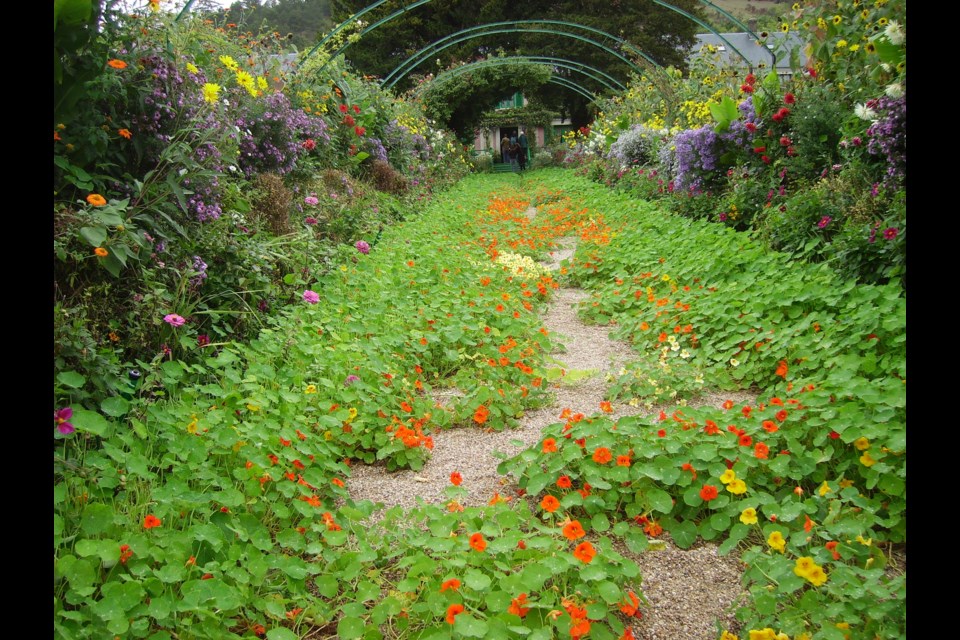It's winter, not much to do in our gardens, but a good time for planning that next overseas adventure. Perhaps the gardens of France could tempt you?
In the fall of 2022, I joined an organized garden tour of Normandy and the Loire Valley. We started from Paris to visit Claude Monet's Garden in Giverny. I had previously visited this garden with a friend in 2009. At that time, we took the train from Paris to Vernon. From Vernon, a short taxi ride brought us to the bread and breakfast we had booked on Rue Claude Monet in Giverny. We spent the next day exploring the little village, Monet's garden and the Musée des Impressionnismes with its attached garden. Giverny was a relaxing experience. I enjoyed the French countryside, the walkability of the sights all along Rue Claude Monet, the cemetery, the small eateries, the impressionist artist shops and Hotel Baudy. If you have an extra day in Paris, avail yourself of a car rental and make Giverny your day excursion.
Claude Monet, the French impressionist painter, famous for his paintings of water lilies, flowers and French bucolic scenes, made Giverny his home for over 40 years, with Alice Hoschedé, whom he later married, and her six children. It was here, in Giverny that he had his painting studio, and where he developed the gardens which provided him with continued inspiration for many of his paintings. The gardens themselves are an artist’s canvas, where the assembly of the whole is more important than its parts. In other words, he used monochromatic borders (borders with flowers of one dominant colour) to create a canvas. One example is the sea of red geraniums in front of the house, a reflection of the red bricks and green trim of the building. In spring the same effect could be achieved with pink and red tulips.
As an individual visitor, you enter the garden through the studio, which Monet had built with exceptionally tall walls, to paint his large water lilies canvasses, as promised to the French Government. This studio is now the gift shop, with reproductions of some of Monet's masterpieces adorning its walls. From the studio, the garden gently slopes down and leads to small meadows of grass, adorned at that time with fall crocuses. These small lawn areas are separated by perennial borders. This part of the garden was once the working farm, where goats were tethered and chickens roamed free. The entire garden was enclosed by walls and originally was a fruit orchard.
As you walk past the meadows and towards the house, you are assaulted with a myriad of colours in the perennial borders. A visit to the house is well worth it. Or better yet, one before the garden and one after. On the second floor, you can get an overview of the entire walled garden. I found the dining room with its many shades of yellow most striking. The studio/living room where Monet liked to work and rest is surrounded today by reproductions of his work and that of other artists. The reproductions have notes as to when they were painted and the name of the work or what inspired the particular canvas.
As you leave the house, feast your eyes on the grand allée, which might look quite different from spring to fall, depending on the plantings of the season. Next, make your way through colourful borders to the right rear corner of the walled garden. From there visitors can access the water lily garden through an underground passage (built for tourists - Monet would have crossed the lane, now a busy roadway and the railway line). The tranquillity of this garden is astonishing compared to the flamboyance of the walled-in garden. Two small row boats are moored in the large lily pond. One is used by a gardener employed only to clean the lily ponds; the other is ready for the artist to step into, sketchbook in hand, to float among the lily pads. A Japanese wisteria-covered bridge completes one of the scenes in this garden, a favourite for tourist photographers. Here the colours seem more muted and the water soothing. Both the pond and the quiet river supplying it as well as the choice of plants and trees contribute to the peaceful and picturesque landscape. The group entrance to the gardens is located near the underground passage. While necessary during busy times, I felt entering through the studio gives one a much better appreciation of the site as a whole.
This column is provided courtesy of the Saskatchewan Perennial Society (SPS; [email protected] ). Check our website (www.saskperennial.ca) or Facebook page (www.facebook.com/saskperennial) for a list of upcoming gardening events.




